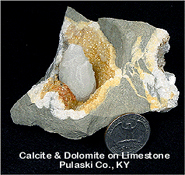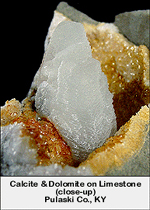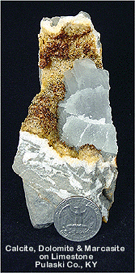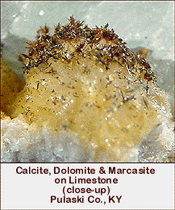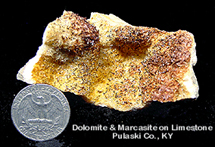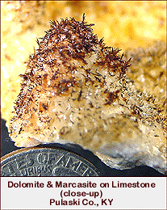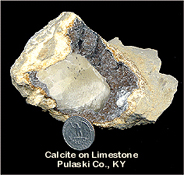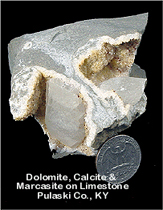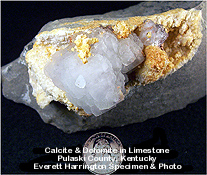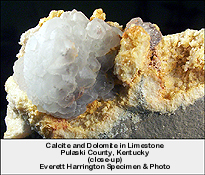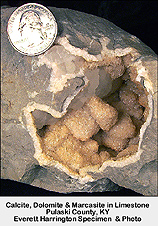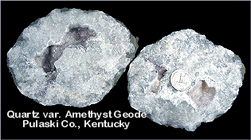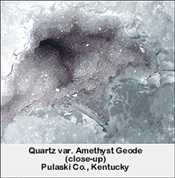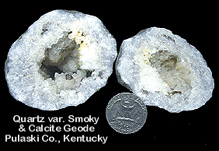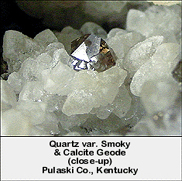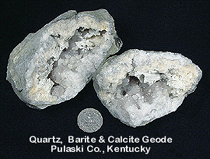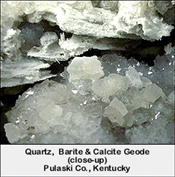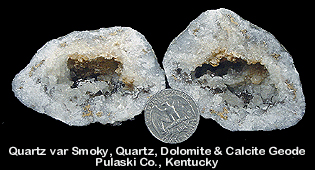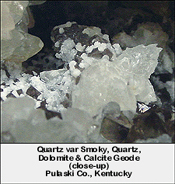The Harringtons made it back about 1/2-hour before dark and boy was Everett excited about what he had seen and found at Ritchie's geode spot. He described an area where countless geodes are contained in a shaley limestone. Chrissy and I got equally excited when Everett produced a few examples of what he found in only about 30 minutes of hunting; most impressive were geode pieces lined with pale yellow calcite crystals resting on dark smoky quartz bases. Yowzer!!! Ritchie was our new best friend, alright - he done real good by us! After this display, there was no doubt about where we would be collecting the next day. We carefully packed up our mineral specimens and headed out, giddy about our prospects for Sunday. After showering and changing clothes, we met up at the Golden Corral restaurant where we put a major dent in the food bar. I can assure you from what I witnessed, no profit could be had for any all-you-can-eat restaurant with a few dozen hungry Everett Harringtons in the house! HA!
We went to bed early and hoped that the weather forecast that called for rain and a high wind advisory over night and into the next day would prove to be wrong. But, unfortunately for us, the weatherman was right and the wind began to howl around midnight followed soon after and throughout the night by intermittent rain squalls. Our Coleman folding camper, with its soft canvas sides, is not designed to stand up to high winds. While it generally helps to align the length of the camper so that it is parallel to the wind direction like a ship at sea, this was not feasible because the wind shifted about 90-degrees from the southeast to the southwest during the night. With up to 45 miles per hour gusts by around 3:00 AM, we were wide awake, unable to sleep from the noise of the camper and a nervous wide-awake Opal who had abandoned her own bed to join us in ours. For some strange reason, it seems that when Opal is afraid, she finds the most comfort by attempting to sit on my head, and this is exactly what she tried to do with every bump and groan of the camper. I find it especially difficult to sleep myself with a 60-pound dog sitting on my face. Although miserable, we made it through the night. From shear exhaustion, I may have managed a couple hours of sleep while Chrissy got maybe an hour. My sleep came only after Opal was banished to the back of the truck. Since the temperature only dipped into the low 50's that night, I am sure that she felt safe and comfortable in the familiar and stable truck.
The wind was still blowing hard when we finally decided to give up trying to sleep at 6:30 AM, but at least the rain had mostly subsided to a few wind driven sprinkles. By the time that Everett and Celia showed up at 7:30, we had fixed and eaten breakfast but weren't quite ready to leave. It seems that some knucklehead left a window down in his brand new Toyota Tundra when he moved it to create a wind break for the camper. To make matters worse, the offending open window was on the windward side of the truck and it looked like a water sprinkler had gone off inside the cab. I would have given the responsible party a piece of my mind, but I couldn't bring myself to be too hard on MYSELF after having experienced such a miserable night. If there was a silver lining to this apparent tragedy, it was that it only rained about 1/4-inch; any more rain and we would have had to bail out the inside of the truck instead of using towels to sop up the water.
With much patience from the Harringtons, we finally headed out in the direction of Richie's collecting spot. Although our spirits had been slightly dampened (pun intended) by the miserable night and its aftermath, it didn't take long before we were looking forward with eager anticipation to finding more rocks and minerals. Although still windy, at least it was not raining and the weather forecast suggested that the wind would subside by late afternoon. However, the overnight low of 52-degrees was ironically supposed to be the high for the day as the temperature was expected to plummet as the day progressed into the low forties with a wind chill in the low thirties. Gale force winds and freezing temperatures - just another happy day of collecting for a group of crazy bundled-up rockhounds - beats working any day!
We parked and followed Everett about 1/2-mile on foot to the collecting area. Celia made a wise decision to stay
behind in the warm car. Opal was confined to the back of our truck because of a plethora of cockle burrs and the cold windy conditions. From past experience in similar conditions, we knew that she would have gotten shivering cold had she been forced to hang out in one spot and, besides, she needed to catch up on her beauty sleep after having spent most of the night trying to sit on my head.
Everett wasn't exaggerating when he told us that there were tons of geodes to be had. We soon discovered an area where countless geodes were sticking out of a relatively soft shaley limestone. For the most part, it was easy to extract them from the rock and there were plenty just laying on the ground having already been liberated by natural forces.
Despite a driving wind and falling temperatures, we managed to stay warm by climbing the limestone outcrops. I had brought along our soil pipe cutter so that we could properly split the geodes.
We alternated our time by collecting and splitting piles of geodes.
Many of the geodes contained strikingly dark smoky quartz and some pale amethyst. While these varieties of quartz are not unheard of, they are relatively rare in Kentucky geodes. I was especially surprised and pleased at the quality of the smoky quartz. As you may know, the characteristic color of smoky quartz occurs when rock crystal quartz is exposed to natural radiation from radioactive elements or adjacent radioactive rocks over long periods of time. The process by which this occurs is not completely understood but it has been theorized that the color is the result of altered oxidation states of the silica molecules caused by radiation. Amethyst's purple color is thought to be the result of two factors: 1) small amounts of iron impurities at specific sites in the crystal structure and, 2) exposure to natural radiation in a manner similar to smoky quartz. Radioactive minerals, such as uraninite, have been identified in Kentucky sedimentary rocks and likely caused the once clear quartz to turn smoky or purple.
The following pictures show some of the more noteworthy specimens that we recovered on that cold and blustery day.
Click on each specimen picture to enlarge
Click on each specimen picture to enlarge
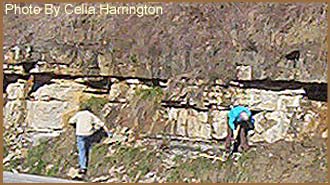 attempt to liberate chunks of limestone with vugs lined with calcite, dolomite, marcasite and other minerals. Chrissy decided to search the vicinity on foot for other collecting opportunities, while Celia did her usual waiting and reading in the rental car and hanging out with Opal who was constrained by a cable connected to the back of our truck. The road was far too busy for us to allow Opal to run free as she normally does when we rockhound, but she stays quite content watching from afar or napping in the back of the truck.
attempt to liberate chunks of limestone with vugs lined with calcite, dolomite, marcasite and other minerals. Chrissy decided to search the vicinity on foot for other collecting opportunities, while Celia did her usual waiting and reading in the rental car and hanging out with Opal who was constrained by a cable connected to the back of our truck. The road was far too busy for us to allow Opal to run free as she normally does when we rockhound, but she stays quite content watching from afar or napping in the back of the truck. 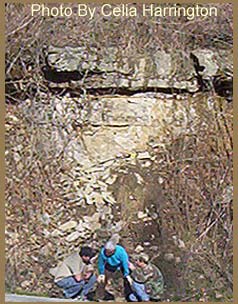 near where Everett was working, about 50 yards away from me. I watched while the stranger approached Everett who greeted him in his usual friendly manner. Since their conversation appeared to be cordial, I went back to what I was doing. About ten minutes later, both men made their way in my direction and Everett hollered up at me to come down to meet Ritchie who had stopped by to see what we were up to. We showed him some of our specimens and, as it turned out, he knew all about rock and mineral collecting, although he claimed to be more interested in hunting Native American artifacts. Although Ritchie was born and raised in the area and lived just up the road from the cut, he had never stopped to check it out himself. He told us that he knew just about every inch of the area having hunting it all his life and that he would be happy to show us a spot where nice geodes could be found. Ritchie was proof positive that Kentucky has some of the most friendly and outgoing people in the country. Since I was right in the middle of working a honey spot and doing so was mostly for Everett's benefit since I had already gotten more fill of specimens from this location, he along with Celia agreed to go with Ritchie to check out the geode location.
near where Everett was working, about 50 yards away from me. I watched while the stranger approached Everett who greeted him in his usual friendly manner. Since their conversation appeared to be cordial, I went back to what I was doing. About ten minutes later, both men made their way in my direction and Everett hollered up at me to come down to meet Ritchie who had stopped by to see what we were up to. We showed him some of our specimens and, as it turned out, he knew all about rock and mineral collecting, although he claimed to be more interested in hunting Native American artifacts. Although Ritchie was born and raised in the area and lived just up the road from the cut, he had never stopped to check it out himself. He told us that he knew just about every inch of the area having hunting it all his life and that he would be happy to show us a spot where nice geodes could be found. Ritchie was proof positive that Kentucky has some of the most friendly and outgoing people in the country. Since I was right in the middle of working a honey spot and doing so was mostly for Everett's benefit since I had already gotten more fill of specimens from this location, he along with Celia agreed to go with Ritchie to check out the geode location. 